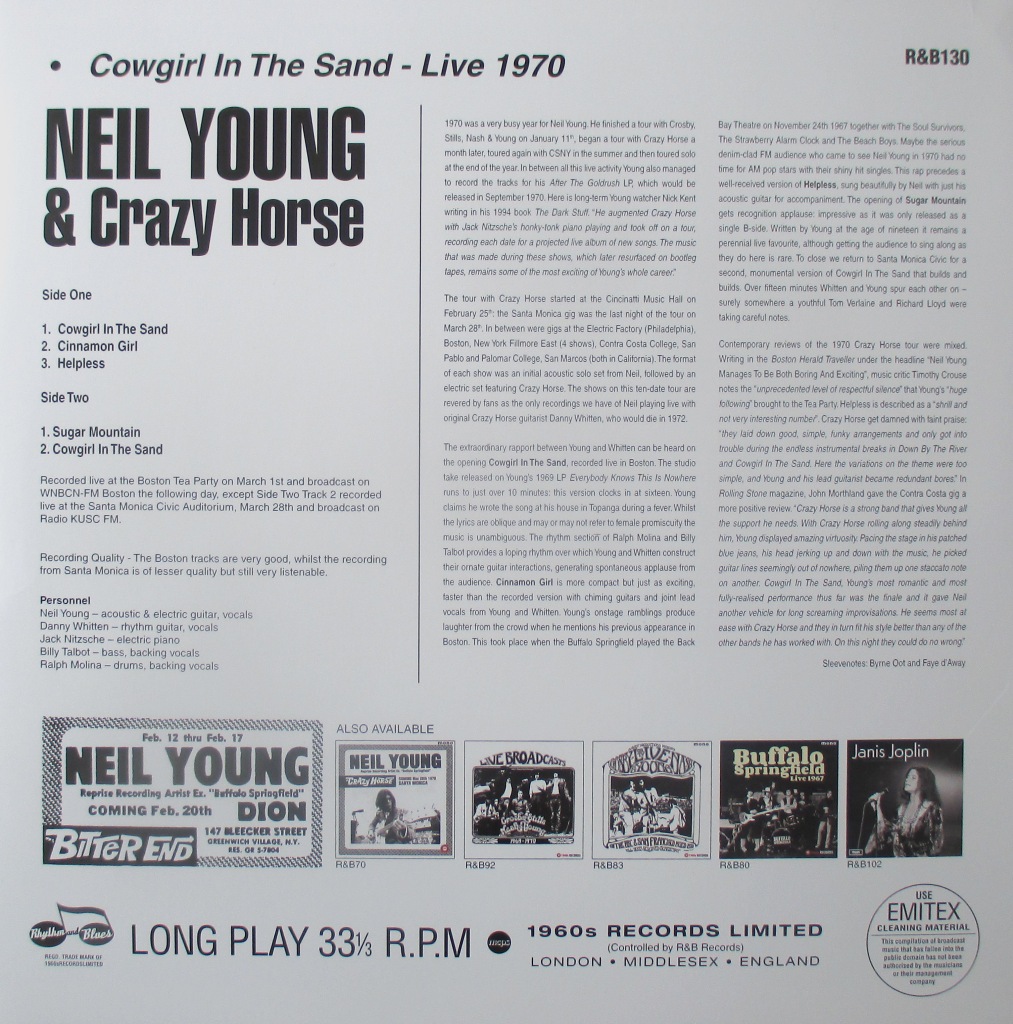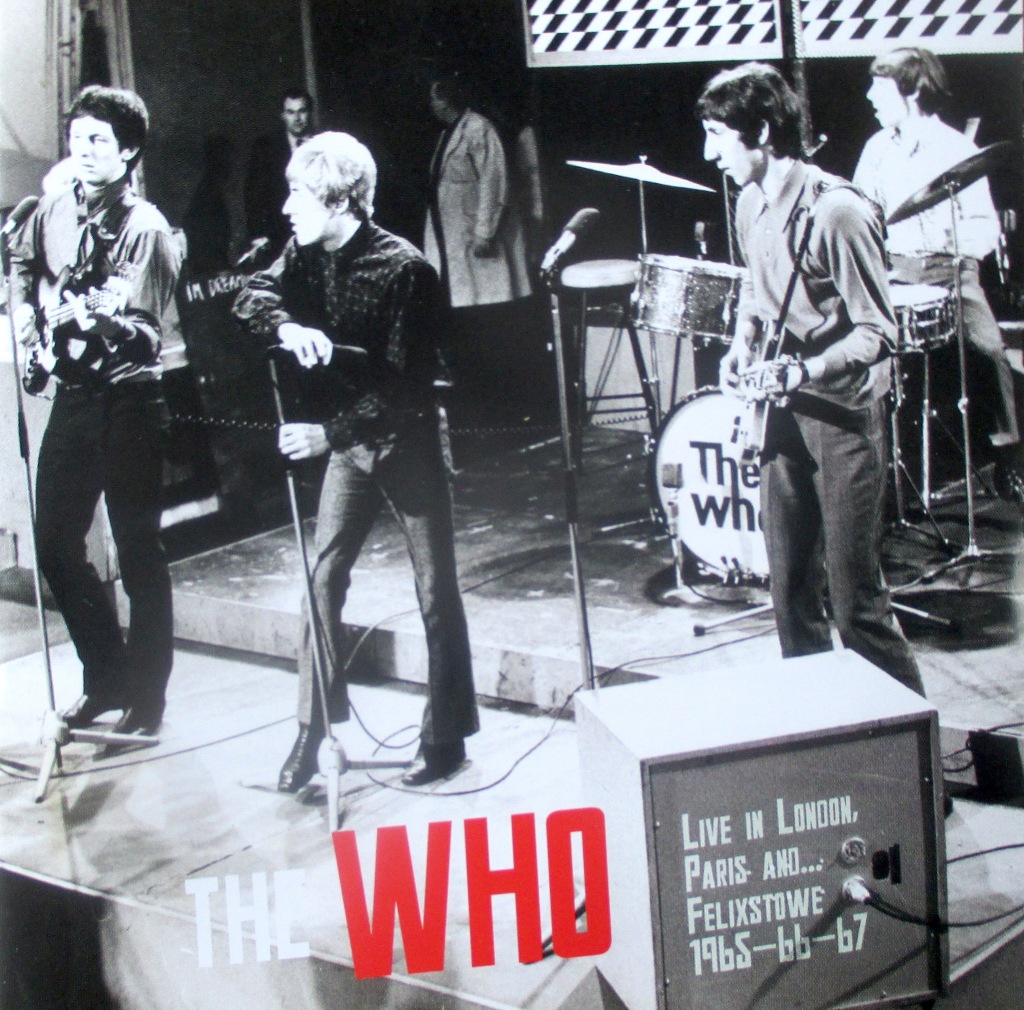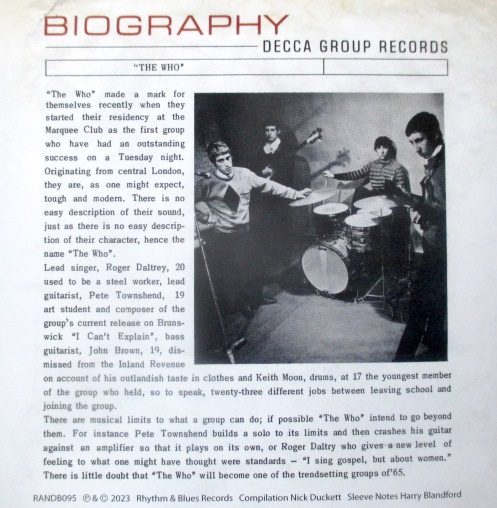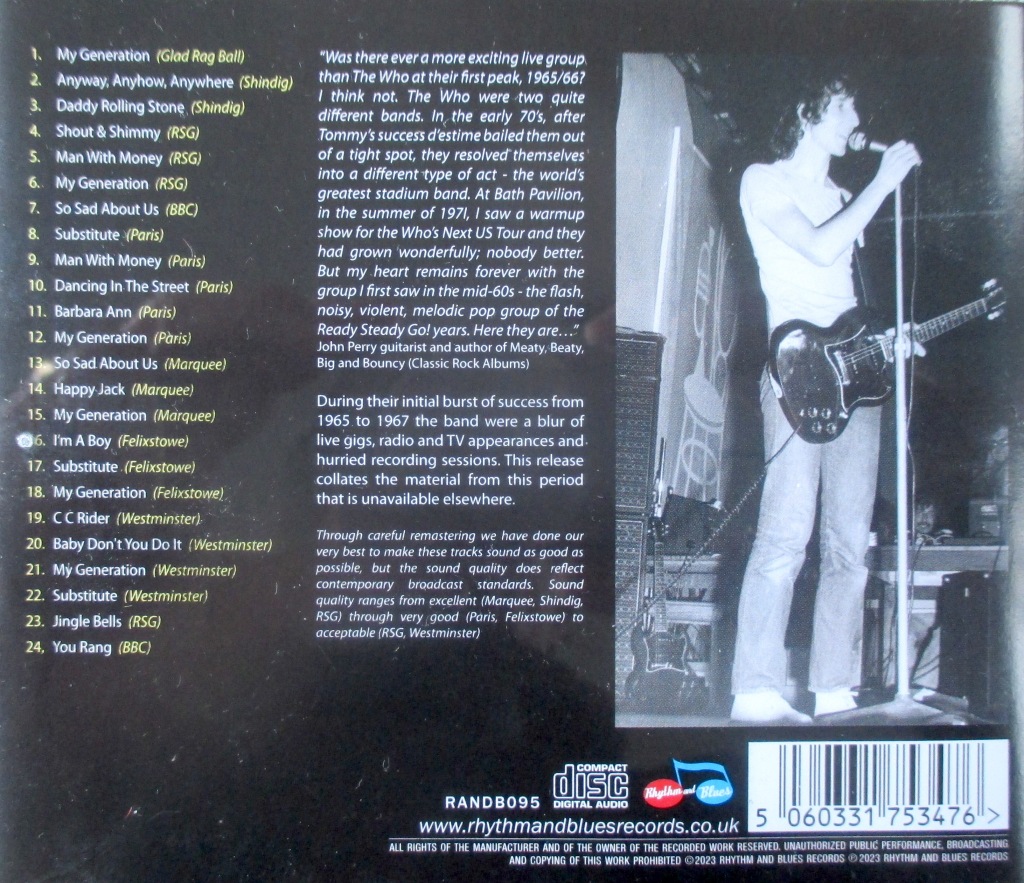New live releases from Neil Young and The Who!
Available now from http://www.1960s.london

Cowgirl In The Sand Live 1970 (Vinyl LP)
Neil Young & Crazy Horse
Side One
- Cowgirl In The Sand
- Cinnamon Girl
- Helpless
Side Two
1Sugar Mountain
2 Cowgirl In The Sand
All songs written by Neil Young
Personnel
Neil Young – acoustic guitar, electric guitar, vocals
Danny Whitten – rhythm guitar, vocals
Billy Talbot – bass, backing vocals
Ralph Molina – drums, backing vocals
Jack Nitzsche – electric piano
Recording details
Side One Tracks 1 – 4 and Side Two Track 1 recorded live at the Boston Tea Party on March 1st and broadcast on WNBCN-FM Boston the following day
Side Two Track 2 recorded live at the Santa Monica Civic Auditorium, March 28th and broadcast on Radio KUSC FM
Recording Quality
The Boston tracks are all very good, whilst the recording from Santa Monica is of lesser quality but still very listenable
Sleevenotes
The reaction to our Neil Young & Crazy Horse Live At Santa Monica Civic LP (R&B 70) has been so positive that we are now issuing a second excerpt from the US tour performed by Neil Young and Crazy Horse in the spring of 1970.
1970 was a very busy year for Neil Young. He finished a tour with Crosby, Stills, Nash & Young on January 11th, began this tour with Crazy Horse a month later, toured again with CSNY in the summer and then toured solo at the end of the year. In between all this live activity Young also managed to record the tracks for his After The Goldrush LP, which would be released in September 1970. Here is long-term Young watcher Nick Kent writing in his 1994 book The Dark Stuff. “He augmented Crazy Horse with Jack Nitzsche’s honky-tonk piano playing and took off on a tour, recording each date for a projected live album of new songs. The music that was made during these shows, which later resurfaced on bootleg tapes, remains some of the most exciting of Young’s whole career.”
The tour with Crazy Horse started at the Cincinatti Music Hall on February 25th: the Santa Monica gig was the last night of the tour on March 28th. In between were gigs at the Electric Factory (Philadelphia), Boston, New York Fillmore East (4 shows), Contra Costa College, San Pablo and Palomar College, San Marcos (both in California). The format of each show was an initial acoustic solo set from Neil, followed by an electric set featuring Crazy Horse. These ten shows are revered by Neil Young fans because they were the only time that Neil played live with original Crazy Horse guitarist Danny Whitten who would die in 1972.
The extraordinary rapport between Young and Whitten can be heard on the opening Cowgirl In The Sand, recorded live in Boston. The studio take released on Young’s 1969 LP Everybody Knows This Is Nowhere runs to just over 10 minutes: this version clocks in at sixteen. Young claims he wrote this song at his house in Topanga whilst suffering from a fever. Whilst the lyrics are oblique and may or may not refer to female promiscuity the music is unambiguous. The rhythm section of Ralph Molina and Billy Talbot provides a loping rhythm over which Young and Whitten construct their ornate guitar interactions which generate spontaneous applause from the audience. Cinnamon Girl is more compact but just as exciting, faster than the recorded version, with chiming guitars and joint lead vocals from Young and Whitten. Young’s onstage ramblings produce laughter from the crowd when he mentions his previous appearance in Boston. This took place when the Buffalo Springfield played the Back Bay Theatre on November 24th 1967 together with The Soul Survivors, The Strawberry Alarm Clock and The Beach Boys. Maybe the serious denim-clad FM audience who came to see Neil Young in 1970 had no time for AM pop stars with their shiny hit singles. This rap precedes a well-received version of Helpless, sung beautifully by Neil with just his acoustic guitar for accompaniment. The opening of Sugar Mountain gets recognition applause: impressive as it was only released as a single B-side. Written by Young at the age of nineteen it remains a perennial live favourite, although getting the audience to sing along as they do here is rare. To close we return to Santa Monica Civic for a second, monumental version of Cowgirl In The Sand that builds and builds. Over fifteen minutes Whitten and Young spur each other on – surely somewhere a youthful Tom Verlaine and Richard Lloyd were taking careful notes.
Contemporary reviews of the 1970 Crazy Horse tour were mixed. Writing in the Boston Herald Traveller under the headline “Neil Young Manages To Be Both Boring And Exciting”, music critic Timothy Crouse notes the “unprecedented level of respectful silence” that Young’s “huge following” brought to the Tea Party. Helpless is described as a “shrill and not very interesting number”. Crazy Horse get damned with faint praise: “they laid down good, simple, funky arrangements and only got into trouble during the endless instrumental breaks in Down By The River and Cowgirl In The Sand. Here the variations on the theme were too simple, and Young and his lead guitarist became redundant bores.” In Rolling Stone magazine, John Morthland gave the Contra Costa gig a more positive review. “Crazy Horse is a strong band that gives Young all the support he needs. With Crazy Horse rolling along steadily behind him, Young displayed amazing virtuosity. Pacing the stage in his patched blue jeans, his head jerking up and down with the music, he picked guitar lines seemingly out of nowhere, piling them up one staccato note on another. Cowgirl In The Sand, Young’s most romantic and most fully-realised performance thus far was the finale and it gave Neil another vehicle for long screaming improvisations. He seems most at ease with Crazy Horse and they in turn fit his style better than any of the other bands he has worked with. On this night they could do no wrong.”
Sleeevenotes: Byrne Oot and Faye d’Away


LIVE IN LONDON, PARIS AND…FELIXSTOWE 1965 – ’67 (CD)
The Who
Tracklisting
- My Generation (Pete Townshend)
- Daddy Rolling Stone (Otis Blackwell)
- Shout & Shimmy (James Brown)
- Man With Money (Don & Phil Everley)
- My Generation (Pete Townshend)
- So Sad About Us (Pete Townshend)
- Substitute (Pete Townshend)
- Man With Money (Don & Phil Everley)
- Dancing In The Street (Marvin Gaye / William Stevenson / Ivy Jo Hunter)
- Barbara Ann (Fred Fassert)
- My Generation (Pete Townshend)
- Happy Jack (Pete Townshend)
- My Generation (Pete Townshend)
- I’m A Boy (Pete Townshend)
- Substitute (Pete Townshend)
- My Generation (Pete Townshend
- C C Rider (Traditionaal)
- My Generation (Townshend
- Baby Don’t You Do It (Holland, Dozier, Holland)
- Substitute (Townshend)
- Jingle Bells (James Lord Pierpoint)
- You Rang ? (Pete Townshend / John Entwistle / Roger Daltrey / Keith Moon)
Recording Details
Track 1 recorded live at the London Students Carnival Ball at the Empire Pool, Wembley on 19/11/65 and transmitted by ATV on 08/12/65
Track 2 recorded live at Twickenham Film Studio for US TV Shindig (ABC) 03/08/65
Tracks 3-5 recorded live for Ready Steady Go! and transmitted 5.11.65
Track 6 Track recorded for BBC Saturday Club at the Playhouse Theatre, London 13/09/66
Tracks 7-11 recorded for ORTF on 31/3/66 at the Music Hall de France, d’Ailleurs, Issy-les-Moulineaux
Tracks 12 & 13 recorded for Beat Club at the Marquee, London 02/03/67 Tracks 14-16 recorded at the Pier Pavilion, Felixstowe on 08/09/66 and broadcast on the French television show Seize Millions Des Jeunes with DJ Emperor Rosko on 18/10/66.
Tracks 17-20 recorded live at Westminster Technical College on 09.07.66 9th and broadcast on Canadian TV CBC Take 30 on 6.10.66
Track 21 recorded for Ready Steady Go! on 17.12.65 and transmitted 24.12.65.
Track 22 recorded for BBC Saturday Club on 15.03.66 and transmitted on 19.03.66
Personnel
Roger Daltrey – vocals
Pete Townshend – guitar, vocals
John Entwistle – bass, vocals
Keith Moon – drums

Sleevenotes
“Was there ever a more exciting live group than The Who at their first peak, 1965/66? I think not. The Who were two quite different bands. In the early 70’s, after Tommy’s success d’estime bailed them out of a tight spot, they resolved themselves into a different type of act – the world’s greatest stadium band. At Bath Pavilion, in the summer of 197I, I saw a warmup show for the Who’s Next US Tour and they had grown wonderfully; nobody better. But my heart remains forever with the group I first saw in the mid-60s – the flash, noisy, violent, melodic pop group of the Ready Steady Go! years. Here they are…”
John Perry (guitarist and author of Meaty, Beaty, Big and Bouncy (Classic Rock Albums)
London, Paris and…Felixstowe. During their initial burst of success from 1965 to 1967 the band were a blur of live gigs, radio and TV appearances and hurried recording sessions. This CD collates the material from this period that is unavailable elsewhere, albeit sometimes in sound quality that reflects contemporary broadcast standards.
Playing under a string of fairy lights the Who offered London’s students a well-behaved version of My Generation, with Pete and John sharing a microphone Beatles-style. The band don’t seem to know how to finish the song without its usual auto-destructive ending, so that at one point only Keith Moon’s extravagant drumming keeps the song from petering out before Townshend weighs in with a final vocal. Other bands on the bill which ran from 9pm to 4 am included Georgie Fame & The Blue Flames, The Hollies, Wilson Pickett and Donovan. Although listed on the bill, the Kinks failed to appear whilst John Lee Hooker was replaced at the last minute by an 18 year old unknown folk singer called Marc Bolan. The Who’s appearance was delayed when Daltrey took exception to the sound quality of the PA provided and refused to perform until the Who’s own PA had been installed. Daddy Rolling Stone was first released by the Who as the B-side to Anyway, Anyhow, Anywhere. The band base their arrangement on Derek Martin’s exhilarating version from 1963, a favourite with the mods in their audience. This recording was made in London for US TV programme Shindig, Townshend in Union Jacket and birdman poses
The TV programme Ready Steady Go! played a vital part in the early success of the Who. In Andy Neill’s definitive book on RSG! Who co-manager Chris Stamp remembers that band and TV programme were in perfect alignment: “we knew we were made for each other. It was an archetypal Sixties happening.” An exciting Shout and Shimmy demonstrates the bands early James Brown fixation with a rare drums-and-bass interlude and the Everly Brothers’ Man With Money gets a powerful finish. Man With Money was a stage favourite but would not appear officially until the 1995 CD re-release of A Quick One. My Generation receives another outing. The Who would appear seventeen times on RSG! and were part of the very last edition on December 23rd 1966 when they played a spirited version of Johnny Kidd’s Please Don’t Touch. BBC sessions were another vital part of the band’s early promotional strategy. So Sad About Us is a song Pete wrote for The Merseys which turned out so well that The Who nicked it for themselves. This fine version was inexplicably omitted from The Who BBC Sessions (1999). Listen for the immaculate harmonies and the new vocal refrain (“Last Night”) at the end.
Next up are five songs recorded for French TV. France got The Who straight away due to the potent combination of their stylish pop-art visual and Townshend’s overt intelligence. The band open with a lively version of Substitute, Townshend delivering an uncharacteristic solo on a Telecaster whilst looking very Brooks Brothers. From the country influences of Man With Money to Motown – why not ? Dancing In the Street is an obvious, mod-orientated choice and features Townshend using a mike stand to get some wayward sounds, his backing vocals on this number being equally experimental. Surf-nut Keith Moon’s falsetto vocals are a feature but not a highlight of Barbara Ann. The closing My Generation is performed quite conservatively with only a solitary cymbal getting knocked over – maybe the band were under heavy manners to behave themselves.
The Who’s spiritual home at this time was The Marquee Club on Wardour Street. In order to support debut single I Can’t Explain, co-manager Kit Lambert arranged for a Tuesday night residency at the Marquee, fly posted using the legendary Maximum R’n’B poster (later to be included with initial copies of Live At Leeds). Bob Bickford of Ready Steady Go! was so impressed by the band’s Marquee performance in front of an audience of rabid Who fans that he recommended the band for a TV slot. These Beat Club tracks give you an idea of what Bob heard on that Tuesday night. A brief and to the point Happy Jack is followed by Townsend again playing slide with the mike stand at the end of My Generation. Before he can total his guitar a smoke-bomb causes the power to fail. Roger is at the height of his Dippity-Do hair-gel dandy phase, the curly haired Rock God still two years away. Entwistle recreates his bass solo in My Generation with impressive and impassive dexterity. And beaming over all he surveys is Keith Moon, the original Happy Jack, visibly having the time of his life.
Next up are frenetic versions of I’m A Boy, Substitute and My Generation recorded on Felixstowe Pier. My Generation ends with Townshend ramming his Rickenbacker into a Marshall amp that bears the scars of previous assaults whilst Moon upends his kit to the presumed delight of the French TV crew filming the gig. Another TV crew, this time from Canada, caught the band in action at Westminster College in July 1966. Footage of this gig shows a rammed college, with as many mod girls as boys. The four song fragments presented here back up the presenters description of the Who as “formidable” and “extraordinary.” C C Rider is a traditional song recorded by (amongst others) Ma Rainey, Mitch Ryder and Elvis Presley, sung here by a deadpan John Entwistle. Marvin Gaye’s Baby Don’t You Do It was a long-time stage favourite and it features Townshend getting into the power chords and melodic explorations that would come to fruition on Live At Leeds (as well as the riff from Satisfaction). We only have the instrumental from Subsitute, complemented by a mighty My Generation where Townshend pulls out all his tricks – incessant windmilling, birdman feedback and finally shoving his sturdy Telecaster into his amp. Daltrey and Moon carry in regardless as the curtain drops. Reviewing a Yeovil gig from later that week the Melody Maker concluded that “there is no other group on the scene remotely like them…”
To complete this rich musical feast we have a couple of rarely heard musical petit fours. A real period piece from the 1965 Christmas Eve edition of RSG!, Jingle Bells features “John on French Horn, Roger on bell, Keith on kazoo and Pete on feedback” (Keith Altham, NME). By contrast You Rang? is a great Ventures-type instrumental in the style of The Ox and this is the only known recording. The words “You Rang?” are uttered by John Entwistle and are taken from the hit TV show The Munsters, where it was the catchphrase of Lurch (Ted Cassidy). A suitably light-hearted note on which to close this selection of songs – neaty, Petey, gig and flouncy.
Sleeve notes: Harry Blandford

